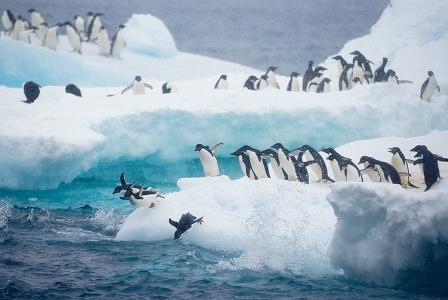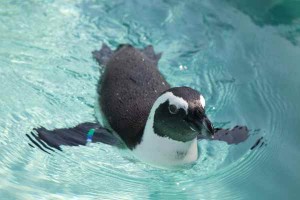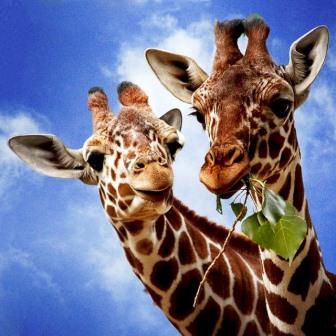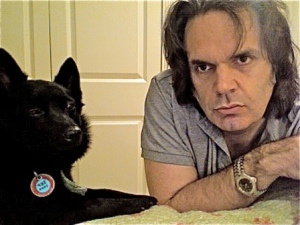The Avatar Paradox
The intimate glimpse into the pulsing center of the natural world that modern technology delivers to us is threatening the natural world as never before.
By Ptolemy Tompkins
![]() For a number of years, I went daily to a well-appointed but singularly ugly gym in New York City. Like most such gyms, it was equipped with several banks of TV screens, set over the jogging and elliptical machines to alleviate the boredom that using such equipment always involves. Jogging along, my eye would drift from one screen to another, drawn solely by whatever was going on visually as I didn’t know how to operate the headphone system that would allow me to hear what was happening on the different stations.
For a number of years, I went daily to a well-appointed but singularly ugly gym in New York City. Like most such gyms, it was equipped with several banks of TV screens, set over the jogging and elliptical machines to alleviate the boredom that using such equipment always involves. Jogging along, my eye would drift from one screen to another, drawn solely by whatever was going on visually as I didn’t know how to operate the headphone system that would allow me to hear what was happening on the different stations.
Going to this gym in the evening after my workday was over, I would often ponder on the singular un-naturalness of my modern urban life. Out beyond the banks of TVs, my fellow fitness-conscious New Yorkers moved about on a vast array of hulking, crab-like weight machines, each of which had been carefully designed to exercise a specific muscle group: muscle groups that the typical New Yorker’s day of sitting at a computer screen so singularly failed to activate. Slowly, doggedly, we were all expending energy: energy that our bodies had been designed to expend, and that they would punish us for failing to release.
Wasn’t there, I would often wonder, a better way of doing all this? Though ostensibly I, and the rest of the people at the gym, were behaving conscientiously and intelligently by devoting this time to our bodies rather than just subjecting them to a few more hours of torpor at home, there would always seem to me to be something vaguely grotesque about the way we had all become so used to clinically siphoning off the daily vigor that our bodies were so anxious to provide us with.
Thoughts like these were on my mind one night when, as I spun and pumped along on one of the elliptical machines, a commercial flashed on one of the TVs over my head.
 I don’t remember what the commercial was for: probably an insurance company or something along those lines. But it featured a few singularly impressive moments of footage of penguins swimming in the Antarctic sea. The birds rocketed along through the polar water, the looming forms of glaciers in the background. Whoever took the footage had gotten so close to the birds that one felt like he or she must practically have become one of them. It was the kind of shot that would have been simply impossible a few short decades ago: the kind that showcased just how stunningly the art of nature photography has advanced in recent years.
I don’t remember what the commercial was for: probably an insurance company or something along those lines. But it featured a few singularly impressive moments of footage of penguins swimming in the Antarctic sea. The birds rocketed along through the polar water, the looming forms of glaciers in the background. Whoever took the footage had gotten so close to the birds that one felt like he or she must practically have become one of them. It was the kind of shot that would have been simply impossible a few short decades ago: the kind that showcased just how stunningly the art of nature photography has advanced in recent years.
Of course, if I’d wanted to, I could have headed up to the Virgin Megastore on Fourteenth Street and purchased a DVD with hours of such footage, but that wasn’t really the point. The point was that for some reason, seeing those impossibly distant and exotic birds rocketing through the water on that TV screen in my gym on that ordinary evening when I and the scores of people around me were draining off the kilocalories of vitality that our urban lives had otherwise failed to demand from us, I found myself wondering at a strange conjunction. We members of the modern world see more of nature, and see it in sharper focus, than any other people born at any other time before us; yet at the same time, when it comes to really experiencing that nature, exactly the opposite is the case.
 The most sophisticated nature photographers aren’t content to photograph animals from a distance (as they did on the nature programs I watched as a kid back in the seventies). They take us right into the action. Whether it’s a penguin rocketing through the Antarctic depths, or a lion taking down a zebra or wildebeest on the plains of the Serengeti, or a South American hummingbird hovering at the edge of a jungle flower, the best modern nature photography imparts a feeling that on one level is profoundly attractive (it feels strangely good to be brought into such close quarters with wild nature), and on another level is just as profoundly disturbing, for at the same time that it charms and dazzles us, this kind of photography also showcases exactly what’s missing from modern existence.
The most sophisticated nature photographers aren’t content to photograph animals from a distance (as they did on the nature programs I watched as a kid back in the seventies). They take us right into the action. Whether it’s a penguin rocketing through the Antarctic depths, or a lion taking down a zebra or wildebeest on the plains of the Serengeti, or a South American hummingbird hovering at the edge of a jungle flower, the best modern nature photography imparts a feeling that on one level is profoundly attractive (it feels strangely good to be brought into such close quarters with wild nature), and on another level is just as profoundly disturbing, for at the same time that it charms and dazzles us, this kind of photography also showcases exactly what’s missing from modern existence.
If a word were needed for that “something,” it might be vitality. There is a particular kind feeling of aliveness that comes from direct participation with the natural world, and in particular with the wild creatures that inhabit it. The peoples who preceded us on this planet knew this feeling well — much, much better than most of us do today. Though they may not, in large part, have been able to observe the animals they lived among with the strange clinical intimacy that modern technology allows us to on our TV or movie screens, they could participate in the lives of those creatures in a way that no telephoto lens allows us to duplicate.
 That’s why certain especially accomplished shots of wild nature – like that clip of penguins in the Antarctic that I saw at the gym that night – can have such a strange and singular effect on us. At their best, these shots give us a powerful glimpse into the very heart of nature, and that glimpse is both enlivening and frustrating, for it reminds us precisely of what’s so disastrously absent from most of our lives today. The intimate glimpses into the pulsing center of the natural world that modern technology so regularly delivers to us, and the feeling of vital intimacy that comes with them, have arrived at precisely the point in world history when that very same technology is threatening its continued existence as it never has before.
That’s why certain especially accomplished shots of wild nature – like that clip of penguins in the Antarctic that I saw at the gym that night – can have such a strange and singular effect on us. At their best, these shots give us a powerful glimpse into the very heart of nature, and that glimpse is both enlivening and frustrating, for it reminds us precisely of what’s so disastrously absent from most of our lives today. The intimate glimpses into the pulsing center of the natural world that modern technology so regularly delivers to us, and the feeling of vital intimacy that comes with them, have arrived at precisely the point in world history when that very same technology is threatening its continued existence as it never has before.
One might call it the Avatar Paradox. James Cameron’s film, with its shamelessly unapologetic yearnings for a life lived within the bosom of a conscious and spiritually charged natural world, is at the same time a pure product of the technology that has destroyed the natural world on our own particular planet. The glowing landscapes that Cameron’s cameras soar through are digital creations, made by people every bit as distanced from the vitality of living nature as the people in my gym. But because they’re such well-made creations, they awaken in us a desperate yearning for a larger, more participative, more living existence. The kind of existence that can only be had when one lives within nature, rather than simply upon it.
Our technology, in the final moments of its destruction of our planet, is throwing up a hint to us: a reminder of what it is that we are really losing with the death of the natural world. It’s not just resources. It’s not just the raw materials that would allow us to continue to survive as a species. It’s not even the pleasure that comes from observing wild nature from a pleasant remove. It’s something more urgent and mysterious than that. Something that, in that flashing shot of penguins swimming beneath the Antarctic seas, I glimpsed that night in the gym: a feeling that the nature we really and truly miss isn’t just “objective” nature, the nature that’s simply “out there,” distanced and separate from us. It’s the nature – the life — which we ourselves participate in with every fiber of our being.
If and when we do kill our planet, that is the true life that we will lose.
~~~~~~~~~~~~~~~~~~~~~~~~~~~~~~
 Ptolemy Tompkins‘ latest book, The Divine Life of Animals, examines the changing views that people have held toward the spirituality of animals over history. He is also the author of Paradise Fever (a memoir about growing up with his father, Secret Life of Plants author Peter Tompkins), The Beaten Path, and This Tree Grows Out of Hell (a spiritual history of the Maya and Aztec cultures). For just under ten years he was an in-house editor at Guideposts and Angels On Earth, and is currently a contributing editor at both magazines. He writes a monthly column for Beliefnet.com called The Winged Life, and is currently working on The Modern Book of the Dead, a contemporary manual on the afterlife modeled loosely on the Egyptian and Tibetan books of the dead, for Atria Books.
Ptolemy Tompkins‘ latest book, The Divine Life of Animals, examines the changing views that people have held toward the spirituality of animals over history. He is also the author of Paradise Fever (a memoir about growing up with his father, Secret Life of Plants author Peter Tompkins), The Beaten Path, and This Tree Grows Out of Hell (a spiritual history of the Maya and Aztec cultures). For just under ten years he was an in-house editor at Guideposts and Angels On Earth, and is currently a contributing editor at both magazines. He writes a monthly column for Beliefnet.com called The Winged Life, and is currently working on The Modern Book of the Dead, a contemporary manual on the afterlife modeled loosely on the Egyptian and Tibetan books of the dead, for Atria Books.
